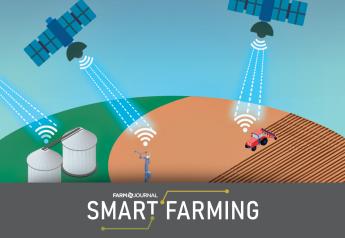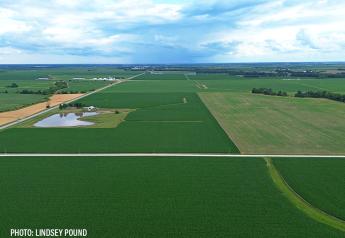Precision Impact Award Winner: Data Deliver Product Insights
The precision-ag team at Simplot Grower Solutions is diligent about making recommendations to its farmer-customers that are profitable. One way the team, based in in Wray, Colo., and Hershey, Neb., respectively, accomplishes that is by using its Field Stripes system, which replicates field-level, agronomic product trials.
At the core of the Field Stripes program is a highly modified spray rig that allows the operator to easily treat, and not treat, a set number of rows with a test product on alternating passes over an entire field. The team modified the 120-foot spray boom with hoses and a custom valve system to allow the operator to “piggyback” a replicated field trial onto a planned application.
The sprayer is set such that each “stripe” corresponds with the size of the farmer’s combine head. So, if the farmer harvests 12 rows with each pass, then the sprayer’s valve system is set to alternate between treatment and control every 12 rows. A normal, scheduled application—for example, with a herbicide—can also include a replicated trial with another product such as a fungicide or foliar nutrients. Using data collected from yield monitors on the combine, the team analyzes differences between treated and untreated 12-row “stripes” in the field. The team also employs a third-party analytical company to review the data for added perspective.
SmartFarm regional manager Caleb Schultz explains that, over the long run, customer relationships and product sales benefit most when the team can prove a product generates profit before selling it to a customer.
Along with Schultz, Simplot’s team includes Amanda Kerbs, area precision agriculture specialist; Bryan Dickson, crop adviser; and David Gleason, precision ag manager. For their work in helping farmers adopt precision ag technologies, the team was named the 2016 Plains-West Region winner of the Precision Impact Award. The award, sponsored by the Agricultural Retailers Association, SST Software and AgPro, recognizes local retail operations for their use of technology, input efficiency, grower engagement, environmental stewardship, innovation and profitability.
For qualified farmer-customers, Simplot provides the Field Stripes product trials at no risk to the grower. “We don’t ask growers to pay for the product unless it provides an economic benefit in the trial,” Schultz says.
When a product produces a yield improvement but the treatment’s cost exceeds its value, the Simplot team uses its data to negotiate pricing with suppliers or influence initial pricing on new products.
Field Stripes works hand in hand with the company’s “Smart Scouting” service, which combines data from weekly GPS-directed tissue sampling, satellite imaging and field scouting. Kerbs compiles those data, along with past yield histories, soil tests, precipitation records and other information, to create GPS-based zone maps for informing precision applications of nutrients or crop-protection products and making decisions on hybrids or varieties.
In several cases, the monitoring has allowed growers to scale back their fertilizer applications without sacrificing yield. Dickson shares the experience of one grower, whose crop rotation includes corn, sugar beets and wheat.
Through the Simplot SmartFarm program, the farmer was able to reduce nitrogen applications to his corn crops from 1 lb. per bushel to just 0.7 lb. per bushel. This reduction was possible due to the holistic zone management approach, managing yield expectations and optimizing nitrogen applications on each crop with intensive zone soil sampling.
Gleason says the team’s data-based zone creation and zone management systems help customers to optimize their agronomic investments. Based on the data and zone maps, they can set realistic yield goals for each zone and manage zones accordingly. The goal, he stresses, is not to maximize yields from every field but to balance production costs and yields to provide the best return on investment for growers.
Entry deadline is Aug. 31, 2017







